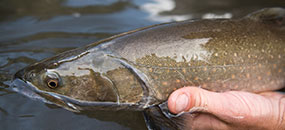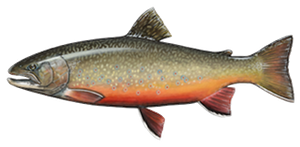Eastside Road Floodplain Restoration Project, White Mountain National Forest
Goals
The White Mountain National Forest, a popular New England vacation destination, is home to hundreds of miles of hiking trails spanning over 4,000-foot mountaintops, 1,250 square miles of wilderness and 600 miles of rivers and streams.
The relatively steep topography makes these streams great candidates for strong Atlantic salmon and brook trout populations. When Tropical Storm Irene tore through New England in August of 2011, it flooded and damaged trail and road infrastructure. This caused not only ruined trails and roads, but also created fish passage barriers and produced heavy sedimentation throughout watersheds such as those of the Pemigewasset, Israel, Saco, Swift, Wildcat, Ellis and Ammonoosuc Rivers.
Trout Unlimited will be assisting the National Forest Foundation and its partners over the next three years not only to rebuild infrastructure from the ground up, but also to better prepare for large storms while improving trout and salmon habitat. This effort will involve multiple federal, state, and non-profit organizations, along with many local volunteers who will be helping to preserve the natural beauty of the White Mountains for generations to come.
Tactics
Trout Unlimited has begun to focus on decommissioning poorly placed trails, stabilizing eroding riverbanks and restoring floodplains that had been impacted by those roads. Another focus is restoring trout habitat connectivity and reducing future flood vulnerability by replacing culverts and bridges. In most cases, decommissioned roads and trails will be replaced by trails that will minimize environmental impacts on streams.
Trout Unlimited and its partners have teamed up to decommission the trail and two culverts that failed in Tropical Storm Irene. The trail will be relocated in late spring of 2015 to a site that reuses a decommissioned road, with TU and its partners replacing two culverts at the new location with a pair of bridges. Once completed, the project will reconnect 18 miles of headwater stream access and prime cold-water brook trout habitat.
Victories
TU and its partners have assessed the impacts of Tropical Storm Irene at a particularly devastated site between the Lincoln Woods and the Franconia Brook tent site. The affected area is a trail that ran alongside the East Branch of the Pemigewasset River known as the Eastside Road and provided motor vehicle access to maintain a tent site. Heavy trail erosion coupled with two failed stream crossing created heavy sedimentation issues.
Trout Unlimited and its partners have teamed up to develop a new trail location that reuses a decommissioned road and began restoring trail erosion impacts, and have leveraged more than $500,000 in funding to work on this project. In addition, the restoration designs are complete, permits are secured, and the replacement bridges have been purchased in preparation for their imminent installation in 2015.
Project partners include: US Forest Service, US Fish & Wildlife Service, New Hampshire Fish & Game Department, and the National Fish and Wildlife Foundation.
Staff Contact
Colin Lawson, New England Culvert Project Coordinator
Author of this Page
Colin Lawson, New England Culvert Project Coordinator




